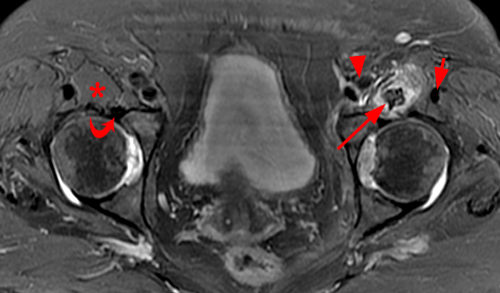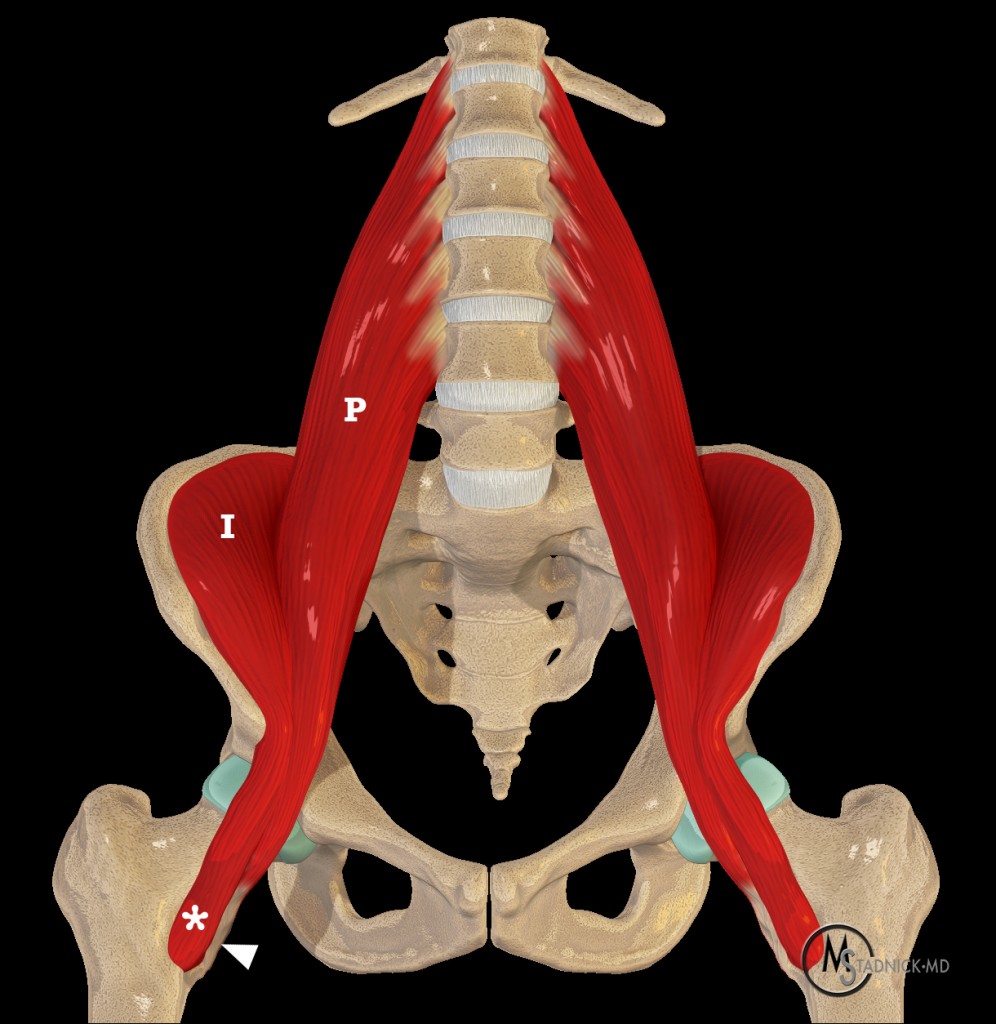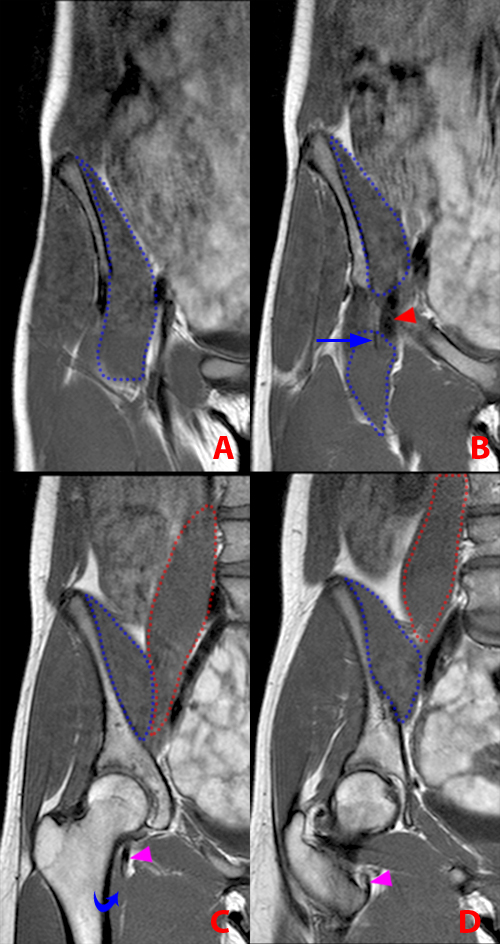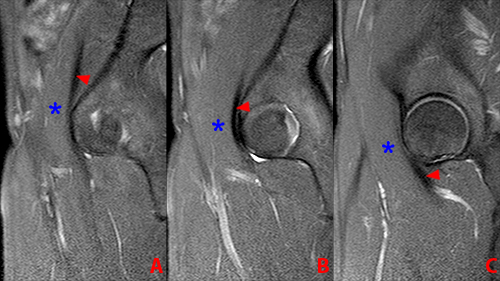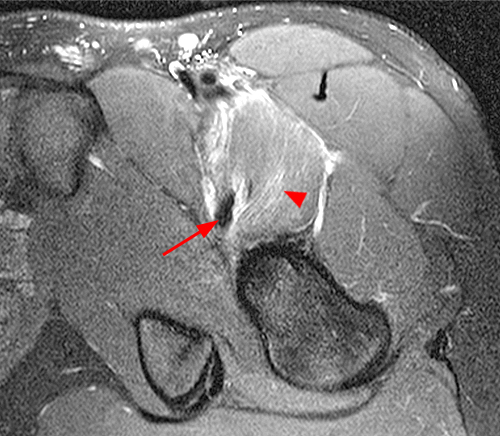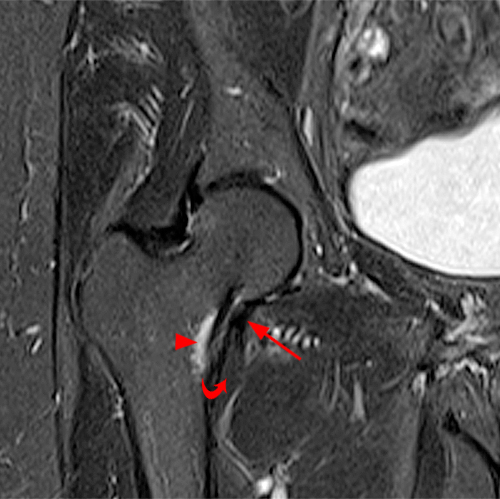Clinical history: A 77 year-old female presents with left groin pain with prominent hip flexion weakness for a month, with no known injury.
What are the findings? What is your diagnosis?
Findings
Figure 2:
(2a) The coronal STIR image demonstrates a complete distal retracted tear of the iliopsoas tendon (arrow), with edema and hemorrhage surrounding the torn and thickened end of the tendon, as well as a strain of the iliacus muscle (asterisk). (2b) The axial STIR image through the femoral heads demonstrates edema surrounding the torn left iliopsoas tendon (arrow), between the unremarkable left rectus femoris tendon (short arrow) and the femoral artery and vein (arrowhead). Normal low-signal at right iliopsoas tendon (curved arrow), and muscle (asterisk).
Figure 3:
(3a) The coronal T1-weighted image, obtained slightly anterior to the lesser trochanter insertion of the iliopsoas tendon and muscle, demonstrates the absence of a defined low-signal tendon near the base of the femoral neck, replaced by diffuse edema (arrow). (3b) The sagittal fat-suppressed proton density-weighted image at the level of the femoral head demonstrates the torn and retracted iliopsoas tendon surrounded by edema, with blood clot or torn muscle tissue distal to the tendon (arrow). The strain of the iliacus muscle (asterisk) is redemonstrated.
Additional information
The patient underwent a follow-up MRI exam 2 months later (Figures 4 and 5) due to persistent mild pain; clinical exam at that time showed return to 80% of normal hip flexion strength.
Figure 4:
A sagittal fat-suppressed proton density-weighted image obtained 2 months after injury in the same patient as Figure 1 demonstrates interval resolution of the fluid which surrounded the torn iliopsoas tendon, with soft tissue continuity from the level of tear to the lesser trochanter insertion.
Diagnosis
Iliopsoas tendon insertional tear, with proximal retraction.
Introduction
The iliopsoas (IP) muscle, although not being visible from the outside, or easily palpated, has been called “the core muscle of the human body”, due to its importance not only as the primary hip flexor, but for its role in optimal postural alignment and back health. It is notable for the number of layman books devoted to this single muscle.1
Although complete ruptures of the iliopsoas tendon present relatively rarely, low-grade injury to the tendon and myotendinous regions, or symptomatic snapping, are seen at all ages, especially related to physical activity. IP tendinopathy may cause acute or chronic pain, and is notoriously difficult to diagnose based on clinical exam or history, due to variable presenting symptoms and the deep mostly inaccessible muscle and tendon location.
MRI allows comprehensive evaluation of the IP tendon and its muscle structures, as well as of the multiple adjacent bone and soft tissue structures of the pelvis, hip and groin regions.
Anatomy and function
The iliopsoas musculotendinous unit consists of the psoas major, the psoas minor, and the iliacus. They provide continuity between the spine and lower extremities, and function in flexion and external rotation of the hip joint, and also have an important function in trunk balance during upright posture and activity; unilateral contraction of the psoas also participates in lateral flexion of the lumbar spine, while bilateral contraction raises the trunk from the supine position.
The term psoas originates from the Greek “psoa” (pronounced with a silent “p”) referring to the loin region. The term iliacus derives from Latin for flank or the part of the body from the lowest ribs to the pubis, and is related to os ilium.
Iliopsoas anatomy
The psoas major muscle is fusiform and unipennate, and measures in the range of 30 cm in length. The muscle has multilevel origins from the ventral surfaces of the transverse processes of the L1 to L5 vertebrae, and multilevel more anterior origin attachments from the lateral aspects of the vertebral bodies as well as the discs from T12-L1 to the L5 level (Figure 6). The psoas muscle increases slightly in cross-sectional diameter distally, and normally is bilaterally symmetric.
Figure 6:
The psoas (P) and iliacus (I) muscles variably fuse below the pelvic brim to form the iliopsoas tendon (arrowhead) which inserts on the lesser trochanter. A muscular component from the iliacus muscle inserts on the anterior aspect of the femur just lateral to the lesser trochanter (asterisk).
The psoas minor is an inconsistent very thin fusiform muscle, located along the anterior aspect of the psoas major muscle, with origin from the T12 and L1 vertebral bodies, and fusing with the psoas major distally or inserting onto the iliopectineal eminence. The psoas minor is absent in approximately 50% of individuals.
The iliacus muscle originates at the superior two thirds of the iliac fossa, and also at the internal lip of the iliac crest, at the ventral surfaces of the iliolumbar and sacroiliac ligaments, and the lateral aspect of the iliac wings.
The course of the psoas major and the iliacus muscles are separate until they blend to a variable degree distally, to form the iliopsoas tendon, with a long region of myotendinous junction at the level of the superior pubic ramus.2 At the level of the superior pelvic brim, the longitudinal axis of the iliopsoas tendon changes orientation, from distal-anterior to distal-posterior, with the extent of angulation related to the position of the hip joint. The angle ranges from 45 to 60 degrees in the sagittal plane during supine extension (Figure 7), with an increase in angle with hip extension.
A variable small central slit with fat tissue may remain between the iliacus and psoas tendons all the way to the lesser trochanter insertion, giving a bifid appearance though the tendons are partially joined by thin anterior and posterior bridging fibers.3 Proximally the tendons are centrally located within the two muscles, but from the level of the hip joint and distally the tendons are eccentrically located at the posterior/deep margin of the muscle, with a considerable amount of muscle tissue present (Figure 2b, normal right iliopsoas). Further distally there is mild tapering of both tendons and muscle tissue towards the lesser trochanter insertion, where the lateral muscle fibers insert directly onto the adjacent femoral cortex, at and slightly distal to the lesser trochanter.3 The psoas tendon rotates in its distal course, so that the anterior tendon margin at level of the femoral head becomes the medial tendon margin at level of the femoral neck. At the lateral groin, the iliopsoas tendon and muscle pass deep to the inguinal ligament and superficial to the superior pubic ramus, in a groove located between the iliopectineal eminence medially and the rectus femoris tendon laterally. The iliopsoas is located superficial to the hip joint, with the psoas tendon often flush against the anterior capsule and labrum. The tendons insert onto a small region at the lesser trochanter of the femur.
The iliopsoas (or iliopectineal) bursa is the largest bursa in the body, extending from the lesser trochanter up to the iliac fossa. The bursa lies deep to the IP tendon and anterior to the hip joint capsule. In approximately 15% of normal individuals, but reportedly higher in individuals with internal derangement of the hip joint, there is a communication between this bursa and the hip joint, located at a defect between the pubofemoral and iliofemoral capsular ligaments of the hip.4 Fluid is not normally present in the IP bursa.
A small lateral muscle component of the iliacus has been termed the iliocapsular muscle, originating from the inferior facet of the AIIS and the anteromedial hip joint capsule, to insert up to 1.5 cm distal to the lesser trochanter of the femur. A rare accessory muscle has been described along the iliopsoas tendon distal-lateral margin, the ilio-infratrochanteric muscle, originating from the region between the anterior superior and inferior iliac spines and inserting as a muscle onto the anterior margin of the lesser trochanter.5
Within the posterior part of the psoas muscle is found the lumbar plexus, formed by anterior parts of the first three and most of the fourth lumbar nerves. The genitofemoral nerve exits through the psoas muscle belly anterior surface, at the L2-3 level. The femoral nerve exits at the crevice between the psoas and the iliacus muscle bellies, anteriorly at the L5 level.
Iliopsoas function
The iliopsoas functions dynamically as a primary hip flexor, with a significant role in advancing the lower limb when walking, running or kicking. In addition it has major static functions, in balancing and stabilizing the body when standing, sitting or lifting. It further adds mechanical stability to the femoral head onto the acetabulum in hip extension to mild flexion. Many investigators have shown major roles of the iliopsoas in providing dynamic stability to the lumbosacral spine, and these multiple roles differ depending upon spinal position and loads being transmitted.6 Myoelectrical recordings have shown individually differing and task-specific activation patterns for the iliacus and the psoas depending on the particular demands for stability and movement at the lumbar spine, pelvis and hip, such as unilateral psoas action causing lateral bending of the body.6
The main antagonist muscle to the iliopsoas is the gluteus maximus.
Normal MRI Appearance
Figure 8:
Sequential coronal T1-weighted images from anterior (A) to posterior (D) demonstrating normal iliopsoas anatomy in a 19 year-old female athlete. The iliacus muscle is indicated in purple and the psoas in red.
(B) The thicker psoas tendon (arrowhead) is seen medial to the thinner iliacus tendon (arrow). Note the significant width and distal extent of the iliopsoas muscle belly (purple margins) both above and below the level of the superior pubic ramus.
(C,D) The iliopsoas tendon is seen at the level of the femoral neck in (C) and at the level of the lesser trochanter at its distal attachment (D). Note that the iliacus muscle is seen well distal to the tendon at level of the anteromedial femoral neck, with a subtle fat plane (curved arrow) along the muscle margin (C).
Figure 9:
Axial T1-weighted images in the same individual as Figure 8.
(A) At level of the sacroiliac joint, the iliacus (blue) and psoas (red) muscle bellies are starting to merge, with the psoas tendon within (arrowhead). The iliacus muscle origin is seen from the iliac crest medial ridge all the way to anterior aspect of the S-I joint.
(B) Slightly further caudal, at the supra-acetabular level, the IP muscle belly extends to the subcutaneous region at the anterior abdominal wall lateral margin, and the small iliacus tendon (blue arrowhead) is present, anterolateral to the larger psoas tendon (red arrowhead).
(C) At level of the femoral head, the psoas tendon is flattened and located immediately anterior to the anterior part of the acetabular labrum and capsule. The smaller iliacus tendon is located nearby, slightly more into the muscle belly anterior to the center of the femoral head.
(D) At the femoral head-neck level, the tendon-muscle unit is slightly triangular in cross-section, with the tendons nearly merging but still seen as separate low-signal structures. Note the sizeable muscle component normally present at this far distal level.
(E) At level of the femoral neck, the psoas and iliacus tendons have merged (red arrowhead) but a thin fat plane persists centrally within the tendon. The IP tendon curves around the neck to a more posterior location, while the muscle belly component remains significant in size and contacts the femoral neck and hip joint capsule.
(F) At level of the lesser trochanter of the femur, the tendon is seen to insert onto bone while the distal muscle belly, still with an AP diameter similar to that of the femur at this level, inserts onto the femur distal to the hip joint capsule (blue arrowhead).
Figure 10:
Sagittal fat-suppressed proton density-weighted images in the same individual as figures 8 and 9.
(A) The sagittal image just medial to the femoral head shows the psoas tendon (red arrowhead) moving from closer to the anterior aspect of the muscle margin, to the posterior margin just above the hip joint. Note the A/P thickness of the IP muscle at this level (blue asterisk).
(B) At a level through the medial aspect of the femoral head the psoas tendon (red arrowhead) is seen to be located anterior to and almost blending with the anterior aspect of the acetabular labrum and capsule.
(C) At a level through the center of the femoral head, the IP tendon (red arrowhead) is seen just before its lesser trochanter femoral insertion as low signal at the femoral head-neck region. The IP muscle belly remains substantial, just proximal to its femoral insertion.
The cross-section size of the psoas muscle varies depending on the functional demands, and can be hypertrophied (Figure 11) or atrophic (Figure 12).
Mechanism of injury and Clinical presentation
Most sports-related injuries to the hip region are musculotendinous, most frequently affecting the quadriceps (especially the rectus femoris) or the adductor muscles (especially the adductor longus). Iliopsoas myotendinous injury, such as a strain or partial tear, is somewhat less common, and may result from acute injury, or present as low-grade chronic symptoms often prevailing for months or even years before the time of diagnosis. Iliopsoas injuries have shown a predilection for individuals involved in activities with repetitive hip flexion and jumping or kicking, such as soccer, gymnastics, dance, rowing, resistance training or horseback riding.2
Non-sports-related pathology of the iliopsoas tendon and muscle include complete tears, which are relatively rare and show a very strong predilection for elderly females (as in the feature case of this review) presenting with hip or groin pain and pronounced weakness in hip flexion without a specific injury and often without any known precursors to the tendon tear. Complete tears may rarely occur in individuals of any age after significant acute trauma.
“Iliopsoas impingement” has been described as an association between iliopsoas scarring or a tight iliopsoas, causing injury leading to a tear of the anterior acetabular labrum, with a predilection for involving young female athletes.7 Iliopsoas impingement has also been described in the setting of a prominent acetabular component of total hip replacement causing IP tendon injury; this may require surgical treatment with tendon release or revision of the acetabular component anterior overhang.8
Clinical presentation and physical examination
Acute complete tears result from load beyond the muscle-tendon tensile strength, and are usually felt as a violent snap followed by weakness in flexion such as an inability to walk up stairs, or lift the leg when sitting. Acute partial-tendon tears or strains are felt as shooting muscle pain, and local tenderness in the groin region.
Overuse injuries usually have an insidious presentation with anterior hip or groin pain, radiating down the anterior thigh toward the knee, occurring first intermittently after exertion, then progressing sometimes over years into pain during exertion, and sometimes to pain present also at rest.
Direct palpation examination of the psoas muscle is limited, due to its deep location, to a small region medial to the anterior superior iliac spine, and may show focal tenderness, especially to pressure on the muscle during resisted active flexion. The IP tendon insertion at the lesser trochanter is likewise difficult to palpate, requiring the patient to lie prone for palpation of the region deep to the gluteal fold.
A positive Ludloff sign is consistent with IP tendinopathy, and is elicited with the patient sitting in a chair, with the hip to be examined already flexed, and the same side’s knee extended. The patient is asked to further elevate that leg which requires using the iliopsoas as the other hip flexors are not activated in this position.
Associated clinical signs
An audible and often palpable snap or click may occur at the hip during flexion or extension, frequently with associated pain, typical for the condition of coxa saltans or “snapping hip”. There are three separate types of coxa saltans: internal, related to the iliopsoas tendon sliding over the iliopectineal eminence of the pubic ramus during hip extension; external, which is the most common type of coxa saltans with symptoms localized laterally over the greater trochanter where the iliotibial band catches as it slides over the greater trochanter during hip flexion; and intra-articular, related to movement within the joint or instability from loose bodies or acetabular labral tears. Key to the diagnosis of internal iliopsoas snapping hip is the ability to reproduce the painful snap during physical examination, with the patient supine, by flexing and abducting the mildly externally rotated hip, then bringing it into extension with mild adduction and mild internal rotation, while feeling and listening for an anterior click or snap. The snapping can be reduced by applying manual pressure over the tendon at the level of the pelvic brim, preventing the lateral-to-medial tendon shift.
Increased lumbar lordosis, and a shortened stride on the affected side, may be observed at postural and gait analysis in individuals with IP tendinopathy. An association has been suggested between tightness of the iliopsoas and other hip flexors which often develops during adolescence, and inhibition of the gluteus maximus, allowing for anterior pelvic tilt which alters biomechanics and leads to increased lumbar disc stresses, facet joint stresses, and may also affect the gait cycle and be associated with patellar tendinitis or patellofemoral dysfunction.2
An association has been shown between clinical findings of psoas contracture and work-related prolonged sitting, which may predispose these individuals to posture issues and back pain.2 In runners, psoas contracture has been associated with a shorter stride and limited performance.2
MRI findings of IP tendon pathology
The MRI manifestations of iliopsoas tendinopathy can be categorized as tendinosis, peritendinitis/iliopsoas bursitis, myotendinous or intramuscular strains, partial tears, and complete tears.
MR images in the axial plane best demonstrate the muscle and tendon and their relationship to adjacent structures, while the sagittal plane is most helpful to evaluate continuity at the common location of injury where the IP tendon and muscle curve around the pelvic brim at level of the femoral head. Coronal images often best demonstrate the distal 3-4 cm of the tendon and its lesser trochanter insertion.
Tendinosis
Traumatic injury or chronic overuse may lead to intratendinous degeneration, with vascular ingrowth, thickening or attenuation of the tendon and possible tearing. Tendinosis may not be associated with symptoms until there is mechanical compromise. Tendinosis is seen as regions of increased signal on T1-weighted images within a tendon, representing myxoid degeneration or angiofibroblastic proliferation, while signal on T2 weighted images remains normal or is mildly abnormal (Figure 13).
Figure 13:
Two coronal T1-weighted images of the right hip in a 22-year-old female with hip pain demonstrate normal low signal at the distal iliopsoas tendon on the first exam (A), but diffuse intermediate signal at the tendon on a follow-up examination 8 months later, compatible with tendinosis (B).
Peritendinitis, bursitis
Inflammatory reaction may occur in fibrovascular tissue surrounding the IP tendon (paratenon) which does not have a tendon sheath, as the tendinous tissue with relatively little vascularity is not prone to inflammatory changes.9 On T2-weighted MR images, peritendinitis is seen as high signal intensity along an intact tendon similar to the findings with IP bursitis (Figure 14). Fluid within the iliopsoas bursa may relate to iliopsoas trauma or overuse, or to arthropathy (especially rheumatoid arthritis) causing synovial inflammation, or may relate to hip disorders and reflect fluid from the hip joint decompressing into the bursa. Rarely the adjacent femoral nerve may be compressed by fluid in an enlarged bursa.10
Myotendinous strain
Muscle strain is manifested on MR images by an often feathery pattern of high T2 signal within part of the muscle (Figures 15 and 16), most commonly at the myotendinous junction. There may also be associated edema or fluid along the muscle fascia (Figure 19).
Figure 14:
Coronal fat-suppressed T2-weighted (A) and axial fat-suppressed proton density-weighted (B) images in another patient reveal fluid within a mildly distended iliopsoas bursa (arrows). The adjacent psoas tendon (arrowheads) and the smaller iliacus tendon slightly further laterally, are well seen.
Figure 15:
(15a) Edema with a feathery pattern within the iliopsoas muscle (arrowhead) compatible with a muscle strain, and fluid along the iliopsoas (arrow) and superficial fascia in a 16-year old female athlete who developed hip pain related to running.
(15b) A corresponding sagittal fat-suppressed proton density-weighted image shows the IP muscle strain longitudinal extent (arrowheads), with edema along the muscle fascia. There was no associated IP tendon tear (arrow) with the tendon continuous on adjacent images.
Tendon partial tears
Partial interruption of the tendon, or a focal region of attenuation, is compatible with partial tearing (Figures 17-19).
Figure 17:
Sagittal fat-suppressed proton density-weighted image in a 67 year-old female with chronic left hip pain who underwent MR imaging to exclude an acetabular labral tear. The image demonstrates a partial tear of the IP tendon, involving the psoas tendon component with an irregular and abnormally lax tendon (arrow).
Tendon complete tears
A complete interruption of the IP tendon usually occurs at or near the distal insertion at the lesser trochanter, and is often associated with proximal retraction of the torn end to approximately the level of the femoral head. The torn end may have well-defined margins or be frayed and thickened; a hematoma or fluid collection is often present around the torn tendon and at the site of retraction (Figures 20-22).
Figure 20:
A coronal STIR image from an 81-year old female with right hip pain and an inability to flex the hip and clinical suspicion of iliopsoas tendinitis or rupture, show a retracted complete IP tendon tear. The tendon in this patient has a bifid appearance, with medial psoas (arrow) and lateral iliacus (arrowhead) components.
Differential diagnosis considerations
Pathology involving the hip joint or the tendons and muscles surrounding the IP musculotendinous complex may mimic the clinical presentation of IP tendinopathy.
Femoral neck stress fracture; Femoral head avascular necrosis
In a retrospective study of 32 patients with IP tendon injuries demonstrated on MRI11, femoral neck stress fracture (Figures 23 and 24) was the most common pre-MRI diagnosis. Hip and groin region pain with insidious onset and pain after or during physical activity are often the only symptoms with either femoral neck stress fractures or IP tendinopathy, and radiographic exams at an early stage may be negative with femoral neck stress fracture, as well as in patients with early femoral head avascular necrosis presenting with vague hip pain. MRI examination is diagnostic for stress fractures and AVN before radiographs become positive.
Figure 24:
A corresponding axial fat-suppressed proton density-weighted image shows the IP tendon and muscle (arrows) along the medial aspect of the femoral neck towards its more posterior lesser trochanter insertion (not shown on this image), separated from the stress reaction (arrowhead) by the low-signal medial capsule (short arrow).
Hip tendinitis, bursitis
Groin and hip region pain similar to that of IP tendinopathy is also seen with the more common tendinopathies involving the gluteus medius and minimus, and with injuries at the rectus femoris tendon origin12,13 at the anterior inferior iliac spine (Figures 25 and 26), and at the adductor tendons of the medial thigh. Hip bursitis usually refers to inflammation and effusions of the trochanteric bursa, located laterally between the greater trochanter and the gluteus maximus muscle, with the smaller adjacent gluteus medius bursa slightly further medially. The ischial bursa located between the hamstring tendons and the ischial tuberosity is less frequently involved.
Figure 25:
An axial fat-suppressed proton density-weighted image in a 44 year-old female with low back pain traveling to right hip, ongoing for 3 years. The MR exam was performed to evaluate for possible avascular necrosis of the femoral head. This image reveals a partial tear of the indirect head of the rectus femoris tendon origin (arrowhead).
Ischiofemoral impingement
The quadratus femoris muscle inserts along the posterior intertrochanteric ridge of the femur, and passes between the femur and the ischial tuberosity where it inserts at the anterior surface. If there is narrowing of the space between these structures, the muscle can become traumatized, leading to edema (Fig 27) and pain, and may result in muscle atrophy and fatty replacement (Fig 28). These findings can be readily demonstrated on MR images.14
Figure 27:
Axial fat-suppressed proton density-weighted MR image in a 22 year-old female with hip pain shows edema within the quadratus femoris muscle (arrow) at a point between the lesser trochanter and the ischial tuberosity (red asterisk), compatible with ischiofemoral impingement. The immediate proximity to the distal aspect of the IP tendon and its trochanteric insertion is shown (yellow asterisk).
Figure 28:
Axial proton density-weighted image demonstrating complete atrophy of the quadratus femoris muscle belly (arrows) in a 71 year-old male with a total hip replacement and hip pain, suggesting ischiofemoral impingement. Note the proximity to the IP tendon (arrowhead) at the lesser trochanter insertion, and to the sciatic nerve (short arrow).
Acetabular labral tear
Acetabular labral tears15 (Fig 29) may cause dull pain at the hip and groin, activity-induced often during or after running or jumping, and sometimes associated with sharp catching pain or popping, which may mimic symptoms from IP tendinopathy, including IP tendon impingement. Sometimes there can be a coexisting labral tear and IP tendinopathy, and it has been postulated that the less common location of labral tears at 3 o’clock (anterior to the acetabular center), where the labrum and capsule are located immediately deep to the IP tendon, may be caused by chronic IP tendon impingement.16 A paralabral cyst is often present in association with acetabular labral tears, and the cyst may mimic fluid within a distended IP bursa.
Figure 29:
Coronal fat-suppressed T2-weighted image of the pelvis in a 16 year-old male cross-country runner who heard a loud pop with pain in his left hip while sprinting and turning. A left hip acetabular labral tear is present (arrow), with a hip joint effusion. A subtle stress reaction is seen at the left femoral neck (asterisk). The iliopsoas tendon (arrowhead) is normal.
Groin injury; Osteitis pubis; pubic ramus stress fracture
“Sportsman’s hernia” or “athletic pubalgia”17 refer to soft tissue injuries involving the lower abdominal wall and groin, notoriously difficult to diagnose, and often not involving actual herniation, as opposed to traditional inguinal hernias involving the inguinal canal. Athletic pubalgia represents a strain or tear at the abdominal and adductor muscles and tendon attachments at the pubic bone, often with tenoperiosteal avulsion of the adductor-rectus abdominus aponeurosis, near the symphysis (Figures 30 and 31). MRI is the imaging study of choice to identify the location and degree of injury.
Figure 30:
A sagittal fat-suppressed T2-weighted image demonstrates a torn left adductor-rectus abdominus aponeurosis with the adductor tendon (arrow) retracted 2 cm. Edema and hemorrhage (asterisk) are seen within the tendon gap and a strain of the rectus abdominus muscle (arrowheads) is evident.
Treatment considerations
Initial recommended therapy for acute muscle strains includes the use of ice and rest, followed by gentle stretching, and because of the iliopsoas muscle tendon complex’s propensity to heal this is the treatment also in cases of partial or complete IP tendon tears. Surgical repair of torn IP tendons is not even described in the medical literature. This may relate to the anatomic features of a relatively thick muscle component being present along the IP tendon all the way to its insertion onto the lesser trochanter, and residual muscle continuity may remain in cases of tendon tears.
Physical therapy has an important role in the rehabilitation of IP tendon injuries of all degrees, especially if there is associated limitation in range of movement attributed to muscle contracture/tightness. The therapy would include iliopsoas stretching, concentric strengthening of the hip external/internal rotators, and eccentric strengthening of the hip flexors and extensors.1,2
Iliopsoas muscle chronic symptomatic tightness may be part of the muscle imbalance associated with prolonged sitting and poor posture termed the “lower crossed syndrome”18, with lumbar hyperlordosis caused by the combination of tightness of the iliopsoas and hip flexors as well as the erector spinae and quadratus lumborum, while there is weakness at the abdominals and the gluteus maximus. As the psoas muscle is active and foreshortened during sitting, participating in the maintenance of upper body positioning and balance, prolonged sitting at work may be associated with psoas major muscle contracture, and mediation by breaks for upright posture or IP stretching exercises have been recommended.2 As the psoas is one of the main muscle “engines” during running, athletes in many sports may experience psoas hypertrophy and a resulting increase in lumbar lordosis, which may affect other biomechanical actions as well.
Patients with symptomatic internal snapping hip represent a subgroup of all patients with IP tendinopathy, where MRI exams usually are non-contributory while dynamic ultrasound examination may demonstrate the involved structures in real-time. These patients also may benefit from physical therapy. In persistent painful snapping, ultrasound-guided iliopsoas bursal injection of corticosteroid and local anesthetic has been shown to provide symptomatic long-term relief in a high percentage of patients.19 The anesthetic procedure also provides predictive information regarding outcome after surgical release of the IP tendon.
Surgical intervention in cases of IP tendinopathy mainly involves tendon release procedures in patients with painful snapping hip refractory to conservative therapies. Surgical release may also be required with rare IP tendon impingement occurring after total hip replacement surgery.8 The tendon release procedure is usually performed as an outpatient arthroscopic procedure of the hip, as the arthroscopic approach has led to fewer complications than earlier direct open approaches. Different techniques have been employed with partial or fractional tendon transection allowing for tendon lengthening, or complete tendon surgical transection, with reduced residual or recurrent symptoms seen with complete transection.20 Tendon transection at level of the femoral head or at the head-neck junction has been recommended instead of transection at the lesser trochanteric insertion, to protect the patients from future flexion weakness.21
Most patients report excellent hip flexor strength already a few months after this procedure, and the majority can return to sports activities and even competitive athletics. There is limited information available regarding the status of the IP tendon after surgical transection. MR images demonstrate the tendon component at the level of the femoral head to account for less than 10% of cross-sectional area, while surgical reports have described a near 50-50 relationship between tendon and muscle of the IP at the surgical transection level, with the muscle part left without transection at the procedure.22 This seeming inconsistency may play a role in the reliable clinical recovery after tenotomies of the iliopsoas.
Remarkably, studies have shown that even competitive athletes report return to full strength of the IP tendon complex after arthroscopic tendon complete transection at level of the acetabular margin22, and rare case reports have described reformation of a tendon-like structure after tenotomy23 suggesting that scarring or some degree of tendon reformation takes place.
Conclusion
Hip pain can be a perplexing problem with a broad clinical differential diagnosis. While iliopsoas low-grade tendinopathy tends to occur in younger individuals usually involved in athletic activities with repetitive hip flexion or kicking, the more rare cases of complete IP tendon tears predominantly are seen in elderly females without predisposing histories. Surgical repair is essentially never used for IP tendon tears; however surgical tendon transection plays a role specifically in the treatment of refractory painful internal snapping hip.
MR imaging is the diagnostic tool of choice for imaging evaluation of the iliopsoas muscle and tendon complex, as well as for the many differential diagnostic possibilities involving bone and soft tissue structures in the hip region.
References
- The Psoas book, by Liz Koch. 2nd edition 2012. ↩
- Iliopsoas tendinitis. Garry JP, Walsh KM. Medscape www.emedicine.medscape.com/article/90993-overview ↩
- MRI and gross anatomy of the iliopsoas tendon complex. Polster JM, Elgabaly M, Lee H et al. Skeletal Radiol 2008:37;55-58 ↩
- Review of iliopsoas anatomy and pathology. Van Dyke JA, Holley HC, Anderson SD. Radiographics 7(1), January 1987 ↩
- Descriptive anatomy of the femoral portion of the iliopsoas muscle. Anatomical basis of anterior snapping of the hip. Tatu L, Parratte B, Vuillier F et al. Surg Radiol Anat 2001:23(6);371-374 ↩
- The role of the psoas and iliacus muscles for stability and movement of the lumbar spine, pelvis and hip. Andersson E, Oddsson L, Grundstrom H, Thorstensson A. Scand J Med Sci Sports 1995, Feb;5(1):10-16 ↩
- Iliopsoas impingement: a newly identified cause of labral pathology in the hip. Domb BG, Shindle MK, McArthur B. HSSJ 2011;7:145-150 ↩
- Anterior iliopsoas impingement and tendinitis after total hip arthroplasty. Lachiewicz PF, Kauk JR. J Am Acad Orthop Surg 2009:17(6):337-44 ↩
- Soft tissue injections in the athlete, with review on pathophysiology of soft tissue injuries in athletes. Nepple JJ, Matava MJ. Sports Health 2009 Sept:1(5);396-404 ↩
- A rare case of femoral neuropathy associated with iliopsoas bursitis after 10 years of total hip arthroplasty. Singh V, Yong Shon W et al. Open Orthop J 2015;9:270-273 ↩
- Iliopsoas injury: an MR study of patterns and prevalence correlated with clinical findings. Bui KL, Llaslan H, Recht M et al. Skeletal Radiol 2008:37;245-249 ↩
- MR Imaging of rectus femoris origin injuries. Ouellette H, Thomas BJ, Nelson E, Torriani M. Skeletal Radiology 2006:35:665-672 ↩
- Rectus femoris tendon injury. MRI Web Clinic. Kerr R. Radsource May 2014 ↩
- Ischiofemoral impingement. MRI Web Clinic. Kerr R. Radsource October 2012 ↩
- Acetabular labral tear. MRI Web Clinic. Howell GA. Radsource November 2013 ↩
- Labral injuries due to iliopsoas impingement: can they be diagnosed on MR arthrography? Blankenbaker DG Tuite MJ Keene JS del Rio AM . AJR Am J Roentgenol. 2012 Oct;199(4):894-900 ↩
- Athletic Pubalgia, MRI Web Clinic. Stadnick, ME. Radsource February 2010 ↩
- Muscles and motor control in low back pain – assessment and management. In: Twomey L (Ed.): Physical therapy of the low back. 1st Ed. Churchill Livingstone; New York; p.253-278. Also: www.jandaapproach.com ↩
- Sonography of the iliopsoas tendon and injection of the iliopsoas bursa for diagnosis and management of the painful snapping hip. Blankenbaker DG, De Smet AA, Keene JS. Skeletal Radiology 2006:35(8);565-571 ↩
- Arthroscopic treatment of symptomatic internal snapping hip with combined pathologies. Duck-Soo Hwang, Jung-Mo Hwang, Pil-Sung Kim et al. Clin Orthop Surg 2015 Jun:7(2):158-163+ ↩
- The surgical treatment of internal snapping hip. Gruen GS, Scioscia TN, Lowenstein JE. American Journal of Sports Medicine 2002:30(4);607-613 ↩
- Results of arthroscopic psoas tendon release in competitive and recreational athletes. Anderson SA, Keen JS. Am J Sports Med December 2008:36(12);2363-2371 ↩
- Iliopsoas tendon reformation after psoas tendon release. Garala K, Power RA. Case reports in orthopaedics 2013, article ID 361087, 4 pages http://dx.doi.org/10.1155/2013/361087 ↩






